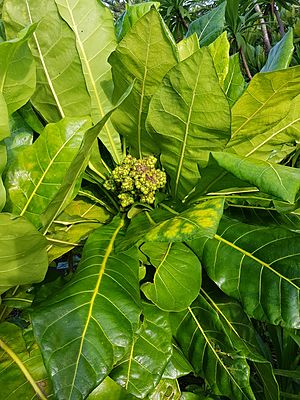Broad-leaved meryta facts for kids
Quick facts for kids Broad-leaved meryta |
|
|---|---|
 |
|
| Conservation status | |
| Scientific classification | |
| Genus: |
Meryta
|
| Species: |
latifolia
|
| Synonyms | |
|
Botryodendrum latifolium Endl. |
|
Meryta latifolia, also known as the broad-leaved meryta or shade tree, is a special evergreen tree. It only grows on Norfolk Island, Australia, which is a small island in the Pacific Ocean. This tree loves warm, moist forests.
Contents
About the Broad-Leaved Meryta
This tree usually has one main trunk and can grow about 5 to 6 meters (16 to 20 feet) tall. That's like a two-story building! It might have a few branches near the top, but its wood is quite fragile.
Its leaves are super big! They can be 50 to 75 centimeters (20 to 30 inches) long and 25 to 30 centimeters (10 to 12 inches) wide. Imagine a leaf bigger than your head! The leaves are shaped like a spear, but upside down. They are narrow at the bottom and wide and rounded at the top.
The female flowers grow in a bunch at the end of the branches. These flower clusters are about 10 to 15 centimeters (4 to 6 inches) long. After the flowers, the tree produces small, round fruits. They are about 5 to 6 millimeters long and have 5 or 6 gentle ridges.
Long ago, people living on Norfolk Island, like convicts, used these large leaves. They would wrap dough in them to bake in the ashes, almost like a natural baking paper!
How It Got Its Name
A scientist named Stephan Endlicher first described this tree in 1792. He gave it the name Botryodendrum latifolium.
Later, in 1862, a German botanist named Berthold Carl Seemann gave the tree its current scientific name, Meryta latifolia.
Where It Lives and Why It's Rare
The broad-leaved meryta is found only on Norfolk Island. It is considered critically endangered. This means it is very close to disappearing forever.
One reason it's so rare is that it's a "dioecious" plant. This means that each tree is either male or female, and you need both a male and female tree close by for them to make seeds.
There are fewer than 150 adult trees left in the wild. Even worse, only about 20 of these are female trees that can produce seeds. This makes it very hard for new trees to grow.
The trees are found in about ten different spots on Norfolk Island. Most of these spots only have one or two trees. Only one place has more than 13 trees. Even in the largest group of about 115 trees, new young trees are not growing.
Scientists are worried because the number of these trees keeps going down. Here are some reasons why:
- There are no special programs to protect or manage them.
- Small groups of trees are easily harmed by big storms like cyclones.
- Weeds that are not native to the island compete with the meryta trees for space and nutrients.
- Rats eat the seeds and young plants.
- Some old trees are dying, and not enough new ones are growing to replace them.
- There are not enough female trees compared to male trees.
- Climate change is also a threat. The tree likes moist forests, so more droughts or very heavy rains can hurt it.
Tree Neighbors
Interestingly, the introduced song thrush bird sometimes builds its nest in the leaves of the broad-leaved meryta tree.
Growing This Tree
It's quite rare to find the broad-leaved meryta growing in gardens. However, it can be grown in warm places that don't get frost, like Sydney, Australia, or Florida in the United States.
If you live in a place that gets a little bit of frost, a similar tree called the New Zealand Puka tree (Meryta sinclairii) might be a better choice. It also has huge broad leaves and can handle temperatures as low as -2 degrees Celsius (28 degrees Fahrenheit) once it's grown.


